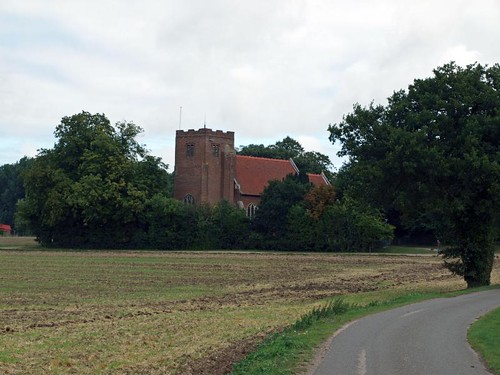ST ANDREW. Early C16 tower of brick, with diagonal buttresses and battlements. Brick W doorway. The rest by E. C. Robins (GR), 1881 Also of red brick, in a Neo-Late-Perp. - FONT. Octagonal with rosettes and shields in the panels. - PLATE. Small Cup with band of ornament, and Paten, both Late Elizabethan.
WEELEY. Pass, Friends, All ’s Well, says its memorial cross; but it is worth while to pause a little, if only to glance at these old cottages and farms they left behind. It is worth while, also, to walk down the lovely lane leading to the red brick church, looking out of place among the old trees overhanging two wide ponds and a quaint thatched barn. Yet the tower is of bricks baked 400 years ago, rare large bricks being used at the bottom and standard ones at the top. Inside hangs a bell of 1400. The rest of the church is modern, but it has a 15th century font, and a Norman shaft with a scalloped capital is used in the sanctuary as a table.
Simon K -
I huffed and puffed up to the church.
Simon K -
Weeley (where do they get these Essex placenames from?) is a big, busy
village, but the church is a mile south of it out in the fields, a
fine setting for a red brick church high on a ridge overlooking the
valley.
Locked. Close up, this is an ugly church. It was entirely rebuilt
apart from the 16th century red brick tower in the 1880s by a minor
architect called Robins who seems not to have even visited the site -
it is an urban church, with wide ugly windows and near-municipal
brickwork. I wasn't bothered about not getting inside. I ate my
sandwiches in the porch looking out over the valley, and then
high-tailed it northwards back through the village along increasingly
hilly roads to Tendring.

No comments:
Post a Comment